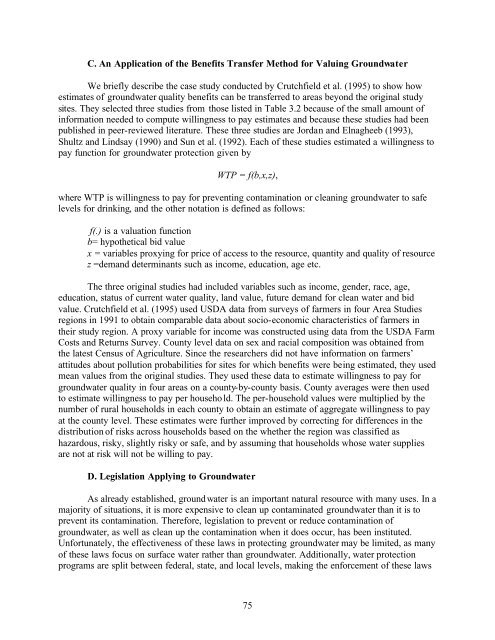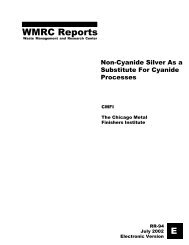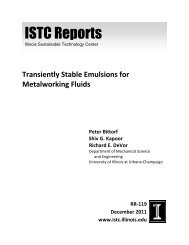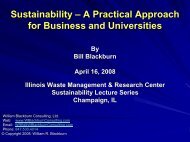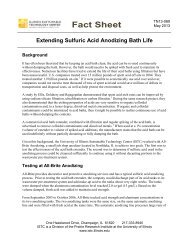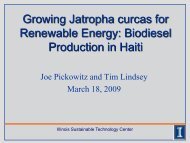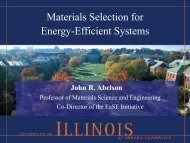Natural Resource Damage Assessment: Methods and Cases
Natural Resource Damage Assessment: Methods and Cases
Natural Resource Damage Assessment: Methods and Cases
You also want an ePaper? Increase the reach of your titles
YUMPU automatically turns print PDFs into web optimized ePapers that Google loves.
C. An Application of the Benefits Transfer Method for Valuing Groundwater<br />
We briefly describe the case study conducted by Crutchfield et al. (1995) to show how<br />
estimates of groundwater quality benefits can be transferred to areas beyond the original study<br />
sites. They selected three studies from those listed in Table 3.2 because of the small amount of<br />
information needed to compute willingness to pay estimates <strong>and</strong> because these studies had been<br />
published in peer-reviewed literature. These three studies are Jordan <strong>and</strong> Elnagheeb (1993),<br />
Shultz <strong>and</strong> Lindsay (1990) <strong>and</strong> Sun et al. (1992). Each of these studies estimated a willingness to<br />
pay function for groundwater protection given by<br />
WTP = f(b,x,z),<br />
where WTP is willingness to pay for preventing contamination or cleaning groundwater to safe<br />
levels for drinking, <strong>and</strong> the other notation is defined as follows:<br />
f(.) is a valuation function<br />
b= hypothetical bid value<br />
x = variables proxying for price of access to the resource, quantity <strong>and</strong> quality of resource<br />
z =dem<strong>and</strong> determinants such as income, education, age etc.<br />
The three original studies had included variables such as income, gender, race, age,<br />
education, status of current water quality, l<strong>and</strong> value, future dem<strong>and</strong> for clean water <strong>and</strong> bid<br />
value. Crutchfield et al. (1995) used USDA data from surveys of farmers in four Area Studies<br />
regions in 1991 to obtain comparable data about socio-economic characteristics of farmers in<br />
their study region. A proxy variable for income was constructed using data from the USDA Farm<br />
Costs <strong>and</strong> Returns Survey. County level data on sex <strong>and</strong> racial composition was obtained from<br />
the latest Census of Agriculture. Since the researchers did not have information on farmers’<br />
attitudes about pollution probabilities for sites for which benefits were being estimated, they used<br />
mean values from the original studies. They used these data to estimate willingness to pay for<br />
groundwater quality in four areas on a county-by-county basis. County averages were then used<br />
to estimate willingness to pay per household. The per-household values were multiplied by the<br />
number of rural households in each county to obtain an estimate of aggregate willingness to pay<br />
at the county level. These estimates were further improved by correcting for differences in the<br />
distribution of risks across households based on the whether the region was classified as<br />
hazardous, risky, slightly risky or safe, <strong>and</strong> by assuming that households whose water supplies<br />
are not at risk will not be willing to pay.<br />
D. Legislation Applying to Groundwater<br />
As already established, groundwater is an important natural resource with many uses. In a<br />
majority of situations, it is more expensive to clean up contaminated groundwater than it is to<br />
prevent its contamination. Therefore, legislation to prevent or reduce contamination of<br />
groundwater, as well as clean up the contamination when it does occur, has been instituted.<br />
Unfortunately, the effectiveness of these laws in protecting groundwater may be limited, as many<br />
of these laws focus on surface water rather than groundwater. Additionally, water protection<br />
programs are split between federal, state, <strong>and</strong> local levels, making the enforcement of these laws<br />
75


